Green and Sustainable Construction Industry: A Systematic Literature Review of the Contractor’s Green Construction Capability
Abstract
1. Introduction
2. Conceptual Boundaries
3. Methodology
3.1. Question Formulation
3.2. Inclusion Criteria
3.3. Search Strategy
3.4. Exclusion Criteria
3.5. Relevant Literature Selection
3.6. Literature Supplementation
- (1)
- Literature supplementation based on references
- (2)
- Literature supplementation based on expert opinion
3.7. Literature Search Summary
4. Descriptive Review of the Literature
4.1. Publication Growth Trends
4.2. Top Research Outlets
4.3. Scientific Collaboration Networks
4.4. Influential Research Highlight
5. Thematic Analysis of the Literature
5.1. Research Cluster 1: What Affects the Implementation of CGCC?
5.1.1. Barriers of CGCC Implementation
5.1.2. Challenges of CGCC Implementation
5.1.3. Drivers of CGCC Implementation
- (1)
- Government dimension
- (2)
- Stakeholder dimension
- (3)
- Company leadership dimension
- (4)
- Company staff dimension
- (5)
- Construction team dimension
5.2. Research Cluster 2: What Is the Performance of CGCC?
5.2.1. Environmental Benefits
5.2.2. Social Benefits
5.2.3. Economic Benefits
5.3. Research Cluster 3: What Is the Profound Impact of CGCC?
5.4. Research Cluster 4: How Does CGCC Promote Green Building?
5.5. Research Cluster 5: What Is the Relationship between CGCC and Sustainability?
6. Summary of Review Findings
7. Theoretical and Practical Contributions
8. Limitations and Further Research Directions
8.1. Limitations
8.2. Further Research Directions
9. Conclusions
Author Contributions
Funding
Institutional Review Board Statement
Informed Consent Statement
Data Availability Statement
Conflicts of Interest
References
- Mokhlesian, S.; Holmén, M. Business model changes and green construction processes. Constr. Manag. Econ. 2012, 30, 761–775. [Google Scholar] [CrossRef]
- Almalkawi, A.T.; Balchandra, A.; Soroushian, P. Potential of using industrial wastes for production of geopolymer binder as green construction materials. Constr. Build. Mater. 2019, 220, 516–524. [Google Scholar] [CrossRef]
- Onubi, H.O.; Hassan, A.S. How environmental performance influence client satisfaction on projects that adopt green construction practices: The role of economic performance and client types. J. Clean. Prod. 2020, 272, 122763. [Google Scholar] [CrossRef]
- Cheng, B.Q.; Lu, K.; Li, J.C.; Chen, H.H.; Luo, X.W.; Shafique, M. Comprehensive assessment of embodied environmental impacts of buildings using normalized environmental impact factors. J. Clean. Prod. 2022, 334, 15. [Google Scholar] [CrossRef]
- Cheng, B.Q.; Huang, J.L.; Lu, K.; Li, J.C.; Gao, G.B.; Wang, T.P.; Chen, H.H. BIM-enabled life cycle assessment of concrete formwork waste reduction through prefabrication. Sustain. Energy Technol. Assess. 2022, 53, 9. [Google Scholar] [CrossRef]
- Cheng, B.Q.; Chang, R.D.; Yin, Q.H.; Li, J.C.; Huang, J.L.; Chen, H.H. A PSR-AHP-GE model for evaluating environmental impacts of spoil disposal areas in high-speed railway engineering. J. Clean. Prod. 2023, 388, 135970. [Google Scholar] [CrossRef]
- He, L.; Chen, L. The incentive effects of different government subsidy policies on green buildings. Renew. Sustain. Energy Rev. 2021, 135, 110123. [Google Scholar] [CrossRef]
- Cheng, B.Q.; Huang, J.L.; Li, J.C.; Chen, S.H.; Chen, H.H. Improving Contractors’ Participation of Resource Utilization in Construction and Demolition Waste through Government Incentives and Punishments. Environ. Manag. 2022, 70, 666–680. [Google Scholar] [CrossRef]
- Cai, J.; Li, Z.F.; Dou, Y.D.; Teng, Y.; Yuan, M.Q. Contractor selection for green buildings based on the fuzzy Kano model and TOPSIS: A developer satisfaction perspective. Eng. Constr. Archit. Manag. 2022. [Google Scholar] [CrossRef]
- Tran, Q.; Nazir, S.; Nguyen, T.H.; Ho, N.K.; Dinh, T.H.; Nguyen, V.P.; Nguyen, M.H.; Phan, Q.K.; Kieu, T.S. Empirical examination of factors influencing the adoption of green building technologies: The perspective of construction developers in developing economies. Sustainability 2020, 12, 8067. [Google Scholar] [CrossRef]
- Sun, H.F.; Mao, W.X.; Dang, Y.G.; Xu, Y.S. Optimum path for overcoming barriers of green construction supply chain management: A grey possibility DEMATEL-NK approach. Comput. Ind. Eng. 2022, 164, 107833. [Google Scholar] [CrossRef]
- RezaHoseini, A.; Noori, S. Integrated scheduling of suppliers and multi-project activities for green construction supply chains under uncertainty. Autom. Constr. 2021, 122, 103485. [Google Scholar] [CrossRef]
- El-Sayegh, S.M.; Basamji, M.; Ahmad, A.H.; Zarif, N. Key contractor selection criteria for green construction projects in the UAE. Int. J. Constr. Manag. 2021, 21, 1240–1250. [Google Scholar] [CrossRef]
- Gurgun, A.P.; Koc, K. Contractor prequalification for green buildings—Evidence from Turkey. Eng. Constr. Archit. Manag. 2020, 27, 1377–1400. [Google Scholar] [CrossRef]
- Setiawan, H.; Ervianto, W.; Han, A. Green Construction Capability Model (GCCM) for Contracting Companies. In IOP Conference Series: Earth and Environmental Science; IOP Publishing: Bristol, England, 2019. [Google Scholar]
- Vrontis, D.; Christofi, M. R&D internationalization and innovation: A systematic review, integrative framework and future research directions. J. Bus. Res. 2021, 128, 812–823. [Google Scholar]
- Hwang, B.-G.; Zhao, X.; Lim, J. Job satisfaction of project managers in green construction projects: Influencing factors and improvement strategies. Eng. Constr. Archit. Manag. 2019, 246, 3. [Google Scholar] [CrossRef]
- Tam, C.M.; Tam, V.W.Y.; Tsui, W.S. Green construction assessment for environmental management in the construction industry of Hong Kong. Int. J. Proj. Manag. 2004, 22, 563–571. [Google Scholar] [CrossRef]
- Lema, R.; Quadros, R.; Schmitz, H. Reorganising global value chains and building innovation capabilities in Brazil and India. Res. Policy 2015, 44, 1376–1386. [Google Scholar] [CrossRef]
- Hirunyawipada, T.; Xiong, G. Corporate environmental commitment and financial performance: Moderating effects of marketing and operations capabilities. J. Bus. Res. 2018, 86, 22–31. [Google Scholar] [CrossRef]
- Hanelt, A.; Bohnsack, R.; Marz, D.; Marante, C.A. A systematic review of the literature on digital transformation: Insights and implications for strategy and organizational change. J. Manag. Stud. 2021, 58, 1159–1197. [Google Scholar] [CrossRef]
- Danese, P.; Manfè, V.; Romano, P. A Systematic Literature Review on Recent Lean Research: State-of-the-art and Future Directions. Int. J. Manag. Rev. 2018, 20, 579–605. [Google Scholar] [CrossRef]
- Appoh, F.; Akilu, Y.K.; Jyoti, S.; Moray, K. Semi-autonomous framework for propulsion subsystem overhaul and refurbishment. In Proceedings of the 2021 International Conference on Artificial Intelligence and Computer Science Technology (ICAICST), Cluj-Napoca, Romania, 28–30 October 2021; IEEE: Piscataway, NJ, USA, 2021. [Google Scholar]
- Lythreatis, S.; Singh, S.K.; El-Kassar, A.-N. The digital divide: A review and future research agenda. Technol. Forecast. Soc. Chang. 2021, 175, 121359. [Google Scholar] [CrossRef]
- Wang, C.L.; Chugh, H. Entrepreneurial Learning: Past Research and Future Challenges. Int. J. Manag. Rev. 2014, 16, 24–61. [Google Scholar] [CrossRef]
- Kauppi, K.; Salmi, A.; You, W. Sourcing from Africa: A Systematic Review and a Research Agenda. Int. J. Manag. Rev. 2018, 20, 627–650. [Google Scholar] [CrossRef]
- Luhar, S.; Luhar, I. Potential application of E-wastes in construction industry: A review. Constr. Build. Mater. 2019, 203, 222–240. [Google Scholar] [CrossRef]
- Asadzadeh, A.; Arashpour, M.; Li, H.; Ngo, T.; Bab-Hadiashar, A.; Rashidi, A. Sensor-based safety management. Autom. Constr. 2020, 113, 103128. [Google Scholar] [CrossRef]
- Edirisinghe, R. Digital skin of the construction site. Eng. Constr. Archit. Manag. 2019, 26, 184–223. [Google Scholar] [CrossRef]
- Ramdani, B.; Raja, S.; Kayumova, M. Digital innovation in SMEs: A systematic review, synthesis and research agenda. Inf. Technol. Dev. 2022, 28, 56–80. [Google Scholar] [CrossRef]
- Squires, J.E.; Valentine, J.C.; Grimshaw, J.M. Systematic reviews of complex interventions: Framing the review question. J. Clin. Epidemiol. 2013, 66, 1215–1222. [Google Scholar] [CrossRef]
- Adams, R.; Jeanrenaud, S.; Bessant, J.; Denyer, D.; Overy, P. Sustainability-oriented Innovation: A Systematic Review. Int. J. Manag. Rev. 2016, 18, 180–205. [Google Scholar] [CrossRef]
- Aramali, V.; Sanboskani, H.; Gibson, G.E.; El Asmar, M.; Cho, N.A. Forward-Looking State-of-the-Art Review on Earned Value Management Systems: The Disconnect between Academia and Industry. J. Manag. Eng. 2022, 38, 03122001. [Google Scholar] [CrossRef]
- Kim, S.; Kim, K. Systematic tertiary study for consolidating further implications of unmanned aircraft system applications. J. Manag. Eng. 2021, 37, 03120001. [Google Scholar] [CrossRef]
- Zhang, Y.C.; Luo, W.Z.; Shan, M.; Pan, D.W.; Mu, W.J. Systematic analysis of PPP research in construction journals: From 2009 to 2019. Eng. Constr. Archit. Manag. 2020, 27, 3309–3339. [Google Scholar] [CrossRef]
- Kiu, M.S.; Chia, F.C.; Wong, P.F. Exploring the potentials of blockchain application in construction industry: A systematic review. Int. J. Constr. Manag. 2020, 22, 1–10. [Google Scholar] [CrossRef]
- Hasan, A.; Ghosh, A.; Mahmood, M.N.; Thaheem, M.J. Scientometric Review of the Twenty-First Century Research on Women in Construction. J. Manag. Eng. 2021, 37, 04021004. [Google Scholar] [CrossRef]
- Shi, Q.; Chen, X.; Xiao, C.; Han, Y.L. Network Perspective in Megaproject Management: A Systematic Review. J. Constr. Eng. Manag. 2022, 148, 03122002. [Google Scholar] [CrossRef]
- Siraj, N.B.; Fayek, A.R. Risk Identification and Common Risks in Construction: Literature Review and Content Analysis. J. Constr. Eng. Manag. 2019, 145, 03119004. [Google Scholar] [CrossRef]
- Yu, Y.; Chan, A.P.C.; Chen, C.; Darko, A. Critical Risk Factors of Transnational Public Private Partnership Projects: Literature Review. J. Infrastruct. Syst. 2018, 24, 04017042. [Google Scholar] [CrossRef]
- Follmer, K.B.; Jones, K.S. Mental Illness in the Workplace: An Interdisciplinary Review and Organizational Research Agenda. J. Manag. 2018, 44, 325–351. [Google Scholar] [CrossRef]
- Cillo, V.; Petruzzelli, A.M.; Ardito, L.; Del Giudice, M. Understanding sustainable innovation: A systematic literature review. Corp. Soc. Responsib. Environ. Manag. 2019, 26, 1012–1025. [Google Scholar] [CrossRef]
- Pak, K.; Kooij, D.T.A.M.; De Lange, A.H.; Van Veldhoven, M.J.P.M. Human Resource Management and the ability, motivation and opportunity to continue working: A review of quantitative studies. Hum. Resour. Manag. Rev. 2019, 29, 336–352. [Google Scholar] [CrossRef]
- Gupta, H.; Barua, M.K. Supplier selection among SMEs on the basis of their green innovation ability using BWM and fuzzy TOPSIS. J. Clean. Prod. 2017, 152, 242–258. [Google Scholar] [CrossRef]
- Qi, G.Y.; Shen, L.Y.; Zeng, S.X.; Jorge, O.J. The drivers for contractors’ green innovation: An industry perspective. J. Clean. Prod. 2010, 18, 1358–1365. [Google Scholar] [CrossRef]
- Hoffman, A.J.; Henn, R. Overcoming the Social and Psychological Barriers to Green Building. Organ. Environ. 2008, 21, 390–419. [Google Scholar] [CrossRef]
- Salem, O.; Solomon, J.; Genaidy, A.; Minkarah, I. Lean Construction: From Theory to Implementation. J. Manag. Eng. 2006, 22, 168–175. [Google Scholar] [CrossRef]
- Tan, Y.; Shen, L.; Yao, H. Sustainable construction practice and contractors’ competitiveness: A preliminary study. Habitat Int. 2011, 35, 225–230. [Google Scholar] [CrossRef]
- Varnäs, A.; Balfors, B.; Faith-Ell, C. Environmental consideration in procurement of construction contracts: Current practice, problems and opportunities in green procurement in the Swedish construction industry. J. Clean. Prod. 2009, 17, 1214–1222. [Google Scholar] [CrossRef]
- Lam, P.T.; Chan, E.H.W.; Poon, C.S.; Chau, C.K.; Chun, K.P. Factors affecting the implementation of green specifications in construction. J. Environ. Manag. 2010, 91, 654–661. [Google Scholar] [CrossRef]
- Salem, O.; Solomon, J.; Genaidy, A.; Luegring, M. Site implementation and assessment of lean construction techniques. Lean Constr. J. 2005, 2, 1–21. [Google Scholar]
- Li, Y.Y.; Chen, P.H.; Chew, D.A.S.; Teo, C.C.; Ding, R.G. Critical Project Management Factors of AEC Firms for Delivering Green Building Projects in Singapore. J. Constr. Eng. Manag. 2011, 137, 1153–1163. [Google Scholar] [CrossRef]
- Berardi, U. Stakeholders’ influence on the adoption of energy-saving technologies in Italian homes. Energy Policy 2013, 60, 520–530. [Google Scholar] [CrossRef]
- Moed, H.F.; Glänzel, W.; Schmoch, U. Handbook of Quantitative Science and Technology Research; Springer: Berlin/Heidelberg, Germany, 2004. [Google Scholar]
- Ren, R.; Hu, W.J.; Dong, J.J.; Sun, B.; Chen, Y.C.; Chen, Z.L. A Systematic Literature Review of Green and Sustainable Logistics: Bibliometric Analysis, Research Trend and Knowledge Taxonomy. Int. J. Environ. Res. Public Health 2020, 17, 261. [Google Scholar] [CrossRef] [PubMed]
- Rosenow, F. An International Comparison of Green Building in Cities. Available online: https://corescholar.libraries.wright.edu/econ_student_papers_economies/20/ (accessed on 30 June 2022).
- Shen, W.; Tang, W.Z.; Siripanan, A.; Lei, Z.; Duffield, C.F.; Hui, F.K.P. Understanding the Green Technical Capabilities and Barriers to Green Buildings in Developing Countries: A Case Study of Thailand. Sustainability 2018, 10, 3585. [Google Scholar] [CrossRef]
- Jiang, W.; Pu, L.Q.; Huang, T.; Yuan, L.; Gan, L. The Effect of Fairness Concern on Carbon Emission Reduction and Revenue Distribution in Construction Supply Chain: Power Structure Perspective. Discret. Dyn. Nat. Soc. 2021, 2021, 20. [Google Scholar]
- Marcelline, T.R.S.; Chengang, Y.; Avotra, A.A.R.N.; Hussain, Z.; Zonia, J.E.; Nawaz, A. Impact of Green Construction Procurement on Achieving Sustainable Economic Growth Influencing Green Logistic Services Management and Innovation Practices. Front. Environ. Sci. 2022, 9, 14. [Google Scholar] [CrossRef]
- Gluch, P.; Gustafsson, M.; Thuvander, L. An absorptive capacity model for green innovation and performance in the construction industry. Constr. Manag. Econ. 2009, 27, 451–464. [Google Scholar] [CrossRef]
- Pinkse, J.; Dommisse, M. Overcoming barriers to sustainability: An explanation of residential builders’ reluctance to adopt clean technologies. Bus. Strategy Environ. 2009, 18, 515–527. [Google Scholar] [CrossRef]
- Xue, X.; Zhang, X.L.; Wang, L.; Skitmore, M.; Wang, Q. Analyzing collaborative relationships among industrialized construction technology innovation organizations: A combined SNA and SEM approach. J. Clean. Prod. 2018, 173, 265–277. [Google Scholar] [CrossRef]
- Shen, L.; Yao, H.; Alan, G. Improving environmental performance by means of empowerment of contractors. Manag. Environ. Qual. Int. J. 2006, 17, 242–257. [Google Scholar]
- Albino, V.; Berardi, U. Green Buildings and Organizational Changes in Italian Case Studies. Bus. Strategy Environ. 2012, 21, 387–400. [Google Scholar] [CrossRef]
- Hwang, B.G.; Shan, M.; Lye, J.M. Adoption of sustainable construction for small contractors: Major barriers and best solutions. Clean Technol. Environ. Policy 2018, 20, 2223–2237. [Google Scholar] [CrossRef]
- Yu, Z.; Lu, C.; San, B. Application of Green Construction Technology in Construction Projects. In Proceedings of the ICCREM, Kunming, China, 27–28 September 2014; pp. 389–397. [Google Scholar]
- Tinker, A.; Kreuter, U.; Burt, R.; Bame, S. Green Construction: Contractor Motivation and Trends in Austin, Texas. J. Green Build. 2006, 1, 118–134. [Google Scholar] [CrossRef]
- Ming, H.Y.; Ahmad Rashid, Z.Z.; Adnan, H. Significant Barriers Influencing Green Design Application among the Contractors in Construction Industry. Int. J. Sustain. Constr. Eng. Technol. 2021, 12, 221–227. [Google Scholar] [CrossRef]
- Abu Ghazaleh, S.N.; Alabady, H.S. Contractual Suggestions for the Contractor in Green Buildings. J. Law Political Sci. 2018, 15, 234–272. [Google Scholar]
- Adetunji, I.; Price, A.; Fleming, P.; Kemp, P. Sustainability and the UK construction industry—A review. Proc. Inst. Civ. Eng. Eng. Sustain. 2003, 156, 185–199. [Google Scholar]
- Wang, W.; Zhang, S.J.; Su, Y.K.; Deng, X.Y. An Empirical Analysis of the Factors Affecting the Adoption and Diffusion of GBTS in the Construction Market. Sustainability 2019, 11, 1795. [Google Scholar] [CrossRef]
- Chang, R.D.; Soebarto, V.; Zhao, Z.Y.; Zillante, G. Facilitating the transition to sustainable construction: China’s policies. J. Clean. Prod. 2016, 131, 534–544. [Google Scholar] [CrossRef]
- Shan, M.; Liu, W.Q.; Hwang, B.G.; Lye, J.M. Critical success factors for small contractors to conduct green building construction projects in Singapore: Identification and comparison with large contractors. Environ. Sci. Pollut. Res. 2020, 27, 8310–8322. [Google Scholar] [CrossRef] [PubMed]
- He, W.; Yang, Y.B.; Wang, W.; Liu, Y.; Khan, W. Empirical study on long-term dynamic coordination of green building supply chain decision-making under different subsidies. Build. Environ. 2022, 208, 13. [Google Scholar] [CrossRef]
- Yang, Z.; Chen, H.; Mi, L.; Li, P.P.; Qi, K. Green building technologies adoption process in China: How environmental policies are reshaping the decision-making among alliance-based construction enterprises? Sustain. Cities Soc. 2021, 73, 15. [Google Scholar] [CrossRef]
- Meng, Q.; Liu, Y.; Li, Z.; Wu, C. Dynamic reward and penalty strategies of green building construction incentive: An evolutionary game theory-based analysis. Environ. Sci. Pollut. Res. 2021, 28, 44902–44915. [Google Scholar] [CrossRef] [PubMed]
- Firdaus, A.; Setiawan, T.H.; Reynaldy, J.I. Barriers to the implementation of green construction: A case study in Bandung, Indonesia. Int. J. Integr. Eng. 2018, 10, 1–7. [Google Scholar] [CrossRef]
- Pham, D.H.; Lee, J.; Ahn, Y. Implementing LEED v4 BD+C Projects in Vietnam: Contributions and Challenges for General Contractor. Sustainability 2019, 11, 5449. [Google Scholar] [CrossRef]
- Teixeira, M.; Zamberlam, J.; Santos, M.; Gomes, C. Change Process for a Sustainable Orientation: Analysis of the Adaptive Capacity of Three Santa Maria (Rs) Building Companies. Rev. De Gest. Ambient. E Sustentabilidade-Geas 2016, 5, 1–17. [Google Scholar]
- Pero, M.; Moretto, A.; Bottani, E.; Bigliardi, B. Environmental Collaboration for Sustainability in the Construction Industry: An Exploratory Study in Italy. Sustainability 2017, 9, 125. [Google Scholar] [CrossRef]
- Abuzeinab, A.; Arif, M. Sustainable Construction Capabilities: A Local Authority Perspective. In Proceedings of the 11th International Post Graduate Research Conference (IPGRC 2013), Media City, UK, 8–10 April 2013. [Google Scholar]
- Ofek, S.; Portnov, B.A. Differential effect of knowledge on stakeholders’ willingness to pay green building price premium: Implications for cleaner production. J. Clean. Prod. 2020, 251, 12. [Google Scholar] [CrossRef]
- Metham, M.; Benjaoran, V.; Sedthamanop, A. An evaluation of Green Road Incentive Procurement in road construction projects by using the AHP. Int. J. Constr. Manag. 2022, 22, 501–513. [Google Scholar] [CrossRef]
- Ajibike, W.A.; Adeleke, A.Q.; Mohamad, F.; Bamgbade, J.A.; Moshood, T.D. The impacts of social responsibility on the environmental sustainability performance of the Malaysian construction industry. Int. J. Constr. Manag. 2021, 10. [Google Scholar] [CrossRef]
- Sang, P.; Liu, J.J.; Zhang, L.; Zheng, L.Q.; Yao, H.N.; Wang, Y.J. Effects of Project Manager Competency on Green Construction Performance: The Chinese Context. Sustainability 2018, 10, 3406. [Google Scholar] [CrossRef]
- Pham, H.; Kim, S.Y. The effects of sustainable practices and managers’ leadership competences on sustainability performance of construction firms. Sustain. Prod. Consum. 2019, 20, 1–14. [Google Scholar] [CrossRef]
- Pham, H.T.; Pham, T.; Quang, H.T.; Dang, C.N. Impact of transformational leadership on green learning and green innovation in construction supply chains. Eng. Constr. Archit. Manag. 2022, 19. [Google Scholar] [CrossRef]
- Lambrechts, W.; Gelderman, C.J.; Semeijn, J.; Verhoeven, E. The role of individual sustainability competences in eco-design building projects. J. Clean. Prod. 2019, 208, 1631–1641. [Google Scholar] [CrossRef]
- Dhingra, R.; Gupta, P. Need Of The Hour: Trained Professionals For Green Buildings. J. Indian Manag. Strategy 2016, 21, 28–33. [Google Scholar] [CrossRef]
- Dang, P.; Niu, Z.W.; Gao, S.; Hou, L.; Zhang, G.M. Critical Factors Influencing the Sustainable Construction Capability in Prefabrication of Chinese Construction Enterprises. Sustainability 2020, 12, 8996. [Google Scholar] [CrossRef]
- Yang, Z.; Fang, H. Research on Green Productivity of Chinese Real Estate Companies—Based on SBM-DEA and TOBIT Models. Sustainability 2020, 12, 3122. [Google Scholar] [CrossRef]
- Zhou, J.; Tam, V.; Qin, Y. Gaps between Awareness and Activities on Green Construction in China: A Perspective of On-Site Personnel. Sustainability 2018, 10, 2266. [Google Scholar] [CrossRef]
- Ershadi, M.; Jefferies, M.; Davis, P.; Mojtahedi, M. Achieving Sustainable Procurement in Construction Projects: The Pivotal Role of a Project Management Office. Constr. Econ. Build. 2021, 21, 45–64. [Google Scholar] [CrossRef]
- Gunhan, S. Analyzing Sustainable Building Construction Project Delivery Practices: Builders’ Perspective. Pract. Period. Struct. Des. Constr. 2019, 24, 10. [Google Scholar] [CrossRef]
- Olawumi, T.O.; Chan, D.W.M. Developing project evaluation models for smart sustainable practices implementation in construction projects: A comparative study between Nigeria and Hong Kong. Eng. Constr. Archit. Manag. 2022, 29, 1522–1552. [Google Scholar] [CrossRef]
- Nahmens, I. From Lean to Green Construction: A Natural Extension. Building a Sustainable Future. In Proceedings of the Construction Research Congress 2009, Seattle, WA, USA, 5–7 April 2009; pp. 1058–1067. [Google Scholar]
- Robinson, H.S.; Anumba, C.J.; Carrillo, P.M.; AI-Ghassani, A.M. STEPS: A knowledge management maturity roadmap for corporate sustainability. Bus. Process Manag. J. 2006, 12, 793–808. [Google Scholar] [CrossRef]
- Opoku, A.; Cruickshank, H.; Ahmed, V. Organizational leadership role in the delivery of sustainable construction projects in UK. Built Environ. Proj. Asset Manag. 2015, 5, 154–169. [Google Scholar] [CrossRef]
- Lin, Y.Q.; Zhang, W.Q. An incentive model between a contractor and multiple subcontractors in a green supply chain based on robust optimization. J. Manag. Anal. 2020, 7, 481–509. [Google Scholar] [CrossRef]
- Onubi, H.O.; Yusof, N.A.; Hassan, A.S. Adopting green construction practices: Health and safety implications. J. Eng. Des. Technol. 2019, 18, 635–652. [Google Scholar] [CrossRef]
- Ariff, R.; Yahya, K.; Sharif, S. The impact of green behavior capability on green construction performance in Indonesia. In Proceedings of the 4th International Conference on Construction and Building Engineering (ICONBUILD) & 12th Regional Conference in Civil Engineering (RCCE ), Langkawi, Malaysia, 20–22 August 2019; Iop Publishing Ltd.: Bristol, UK. [Google Scholar]
- Salehi, M.; Majbouri Yazdi, H.; Nekoei, M. The effect of communication capabilities of suppliers and external green integration on the green and financial performance in Iran. Qual. Res. Financ. Mark. 2018, 10, 309–323. [Google Scholar] [CrossRef]
- Ariff, R.; Sharif, S.; Yahya, K. Green construction capability for environmental sustainability performance: An empirical study on construction sector in Indonesia. In Proceedings of the 4th International Conference on Construction and Building Engineering (ICONBUILD) & 12th Regional Conference in Civil Engineering (RCCE), Langkawi, Malaysia, 20–22 August 2019; Iop Publishing Ltd.: Bristol, UK. [Google Scholar]
- Onubi, H.O.; Yusof, N.A.; Hassan, A.S. Effects of green construction on project’s economic performance. J. Financ. Manag. Prop. Constr. 2020, 25, 331–346. [Google Scholar] [CrossRef]
- Onubi, H.O.; Yusof, N.; Hassan, A.S. Green construction practices: Ensuring client satisfaction through health and safety performance. Environ. Sci. Pollut. Res. 2022, 29, 5431–5444. [Google Scholar] [CrossRef]
- Onubi, H.O.; Yusof, N.; Hassan, A.S. The moderating effect of client types on the relationship between green construction practices and health and safety performance. Int. J. Sustain. Dev. World Ecol. 2020, 27, 732–748. [Google Scholar] [CrossRef]
- Onubi, H.O.; Yusof, N.; Hassan, A.S.; Bahdad, A.A.S. Analyzing the mediating effect of economic performance on the relationship between green construction practices and health and safety performance in Nigeria. Environ. Sci. Pollut. Res. 2021, 28, 36598–36610. [Google Scholar] [CrossRef]
- Chang, R.D.; Zuo, J.; Soebarto, V.; Zhao, Z.Y.; Zillante, G. Dynamic interactions between sustainability and competitiveness in construction firms A transition perspective. Eng. Constr. Archit. Manag. 2017, 24, 842–859. [Google Scholar] [CrossRef]
- Yuan, Z.; Fang, Y.Q.; Hong, J.K.; Zhang, Q.; Zhang, Z.Y.; Ni, G.D. Coupling Relationship between Capabilities and Benefits of Lean Construction for Precast Buildings from a Multivariable Moderation Perspective. J. Constr. Eng. Manag. 2022, 148, 04022011. [Google Scholar] [CrossRef]
- Onubi, H.O.; Yusof, N.; Hassan, A.S. Understanding the mechanism through which adoption of green construction site practices impacts economic performance. J. Clean. Prod. 2020, 254, 10. [Google Scholar] [CrossRef]
- Xia, W.F.; Li, B.Z.; Yin, S. A Prescription for Urban Sustainability Transitions in China: Innovative Partner Selection Management of Green Building Materials Industry in an Integrated Supply Chain. Sustainability 2020, 12, 2581. [Google Scholar] [CrossRef]
- Udomsap, A.D.; Hallinger, P. A bibliometric review of research on sustainable construction, 1994–2018. J. Clean. Prod. 2020, 254, 120073. [Google Scholar] [CrossRef]
- Rehman, S.U.; Bhatti, A.; Kraus, S.; Ferreira, J.J.M. The role of environmental management control systems for ecological sustainability and sustainable performance. Manag. Decis. 2021, 59, 2217–2237. [Google Scholar] [CrossRef]
- Robichaud, L.B.; Anantatmula, V.S. Greening Project Management Practices for Sustainable Construction. J. Manag. Eng. 2011, 27, 48–57. [Google Scholar] [CrossRef]
- Liu, Z.J.; Pyplacz, P.; Ermakova, M.; Konev, P. Sustainable Construction as a Competitive Advantage. Sustainability 2020, 12, 5946. [Google Scholar] [CrossRef]
- Hwang, B.-G.; Zhu, L.; Ming, J.T.T. Factors Affecting Productivity in Green Building Construction Projects: The Case of Singapore. J. Manag. Eng. 2017, 33, 04016052. [Google Scholar] [CrossRef]
- Hwang, B.G.; Tan, J.S. Green building project management: Obstacles and solutions for sustainable development. Sustain. Dev. 2012, 20, 335–349. [Google Scholar] [CrossRef]
- Ahn, Y.H.; Jung, C.W.; Suh, M.; Jeon, M.H. Integrated Construction Process for Green Building. Procedia Eng. 2016, 145, 670–676. [Google Scholar] [CrossRef]
- Criado-Perez, C.; Shinkle, G.A.; Hollerer, M.A.; Sharma, A.; Collins, C.; Gardner, N.; Haeusler, M.H.; Pan, S. Digital Transformation in the Australian AEC Industry: Prevailing Issues and Prospective Leadership Thinking. J. Constr. Eng. Manag. 2022, 148, 05021012. [Google Scholar] [CrossRef]
- Pan, R. Study and Discuss on Green Construction Principle and Construction Environmental Loads Assessment. In Proceedings of the International Conference on Construction and Real Estate Management, Beijing, China, 5–6 November 2009; China Architecture & Building Press: Beijing, China, 2009. [Google Scholar]
- Pan, R. Study on green construction and index system of green construction assessment. In Proceedings of the 2010 IEEE 17th International Conference on Industrial Engineering and Engineering Management, Xiamen, China, 29–31 October 2010. [Google Scholar]
- Bamgbade, J.A.; Kamaruddeen, A.M.; Nawi, M.N.M.; Adeleke, A.Q.; Salimon, M.G.; Ajibike, W.A. Analysis of some factors driving ecological sustainability in construction firms. J. Clean. Prod. 2019, 208, 1537–1545. [Google Scholar] [CrossRef]
- Henn, R.L.; Hoffman, A.J. Constructing Green: The Social Structures of Sustainability; Henn, R.L., Hoffman, A.J., Eds.; The MIT Press: Cambridge, MA, USA, 2013. [Google Scholar]
- Tafazzoli, M.; Mousavi, E.; Kermanshachi, S. Opportunities and Challenges of Green-Lean: An Integrated System for Sustainable Construction. Sustainability 2020, 12, 4460. [Google Scholar] [CrossRef]
- Dixit, S.; Mandal, S.N.; Sawhney, A.; Singh, S. Area of linkage between lean construction and sustainability in Indian construction industry. Int. J. Civ. Eng. Technol. 2017, 8, 623–636. [Google Scholar]
- Christofi, M.; Leonidou, E.; Vrontis, D. Marketing research on mergers and acquisitions: A systematic review and future directions. Int. Mark. Rev. 2017, 34, 629–651. [Google Scholar] [CrossRef]
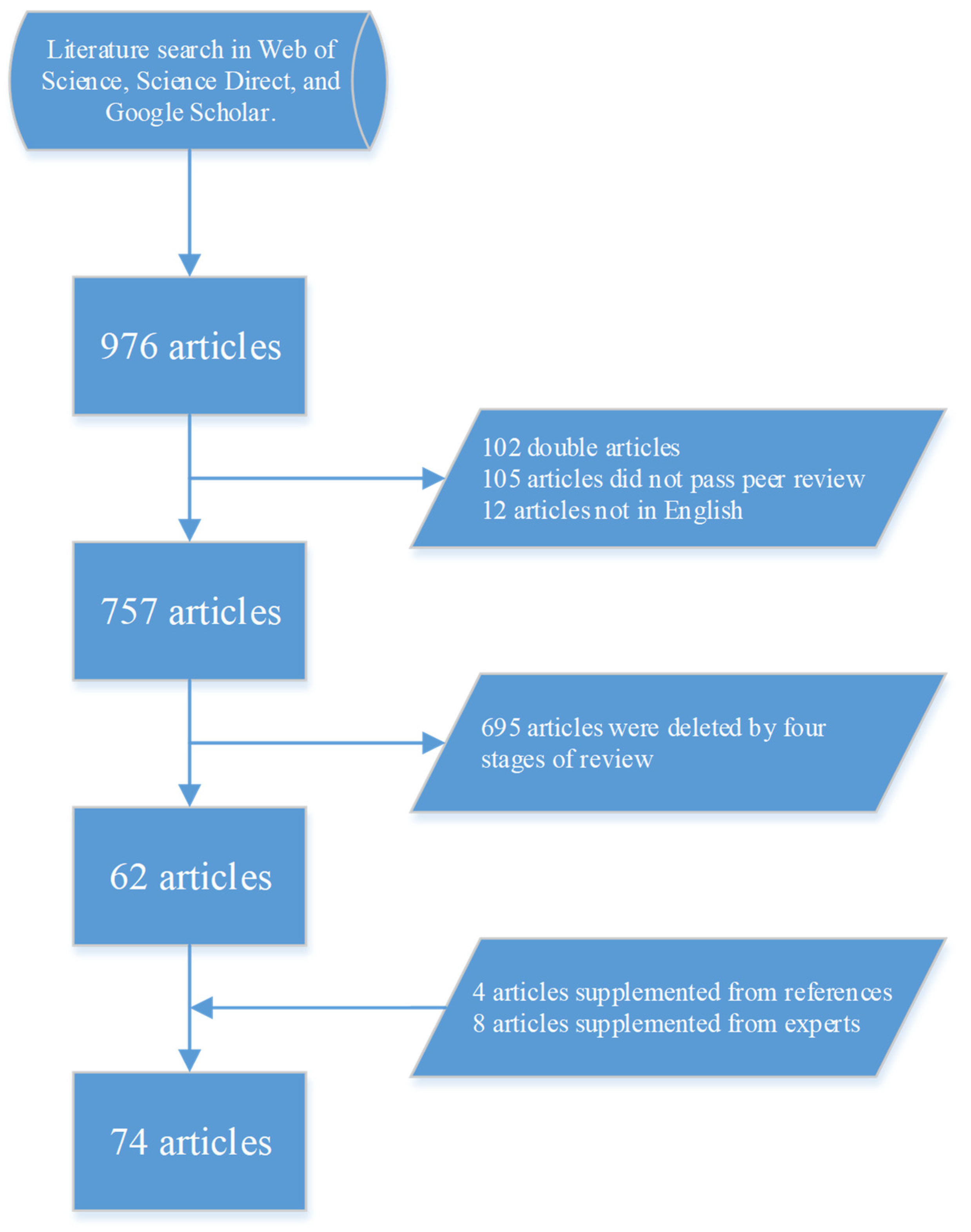

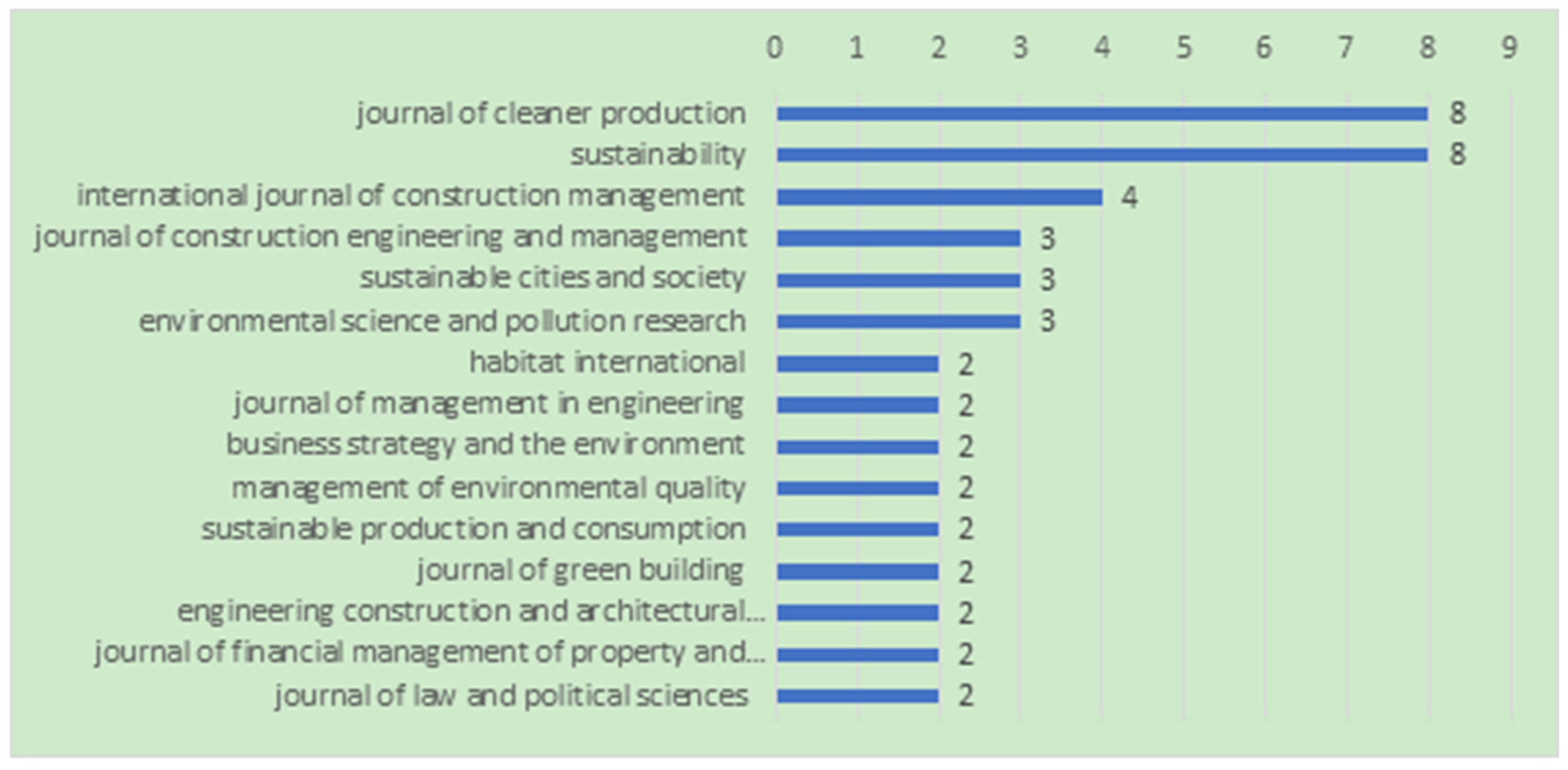
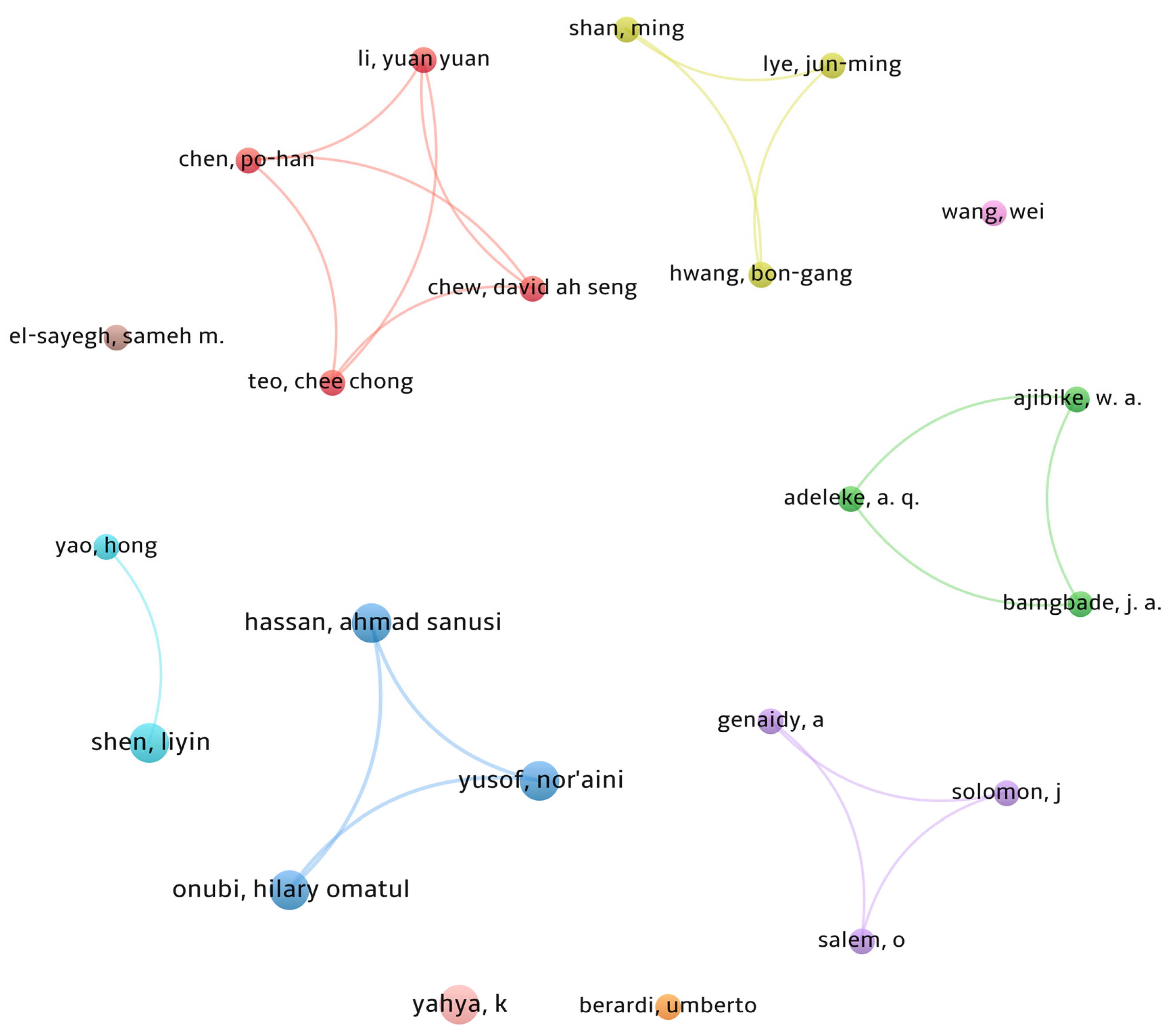
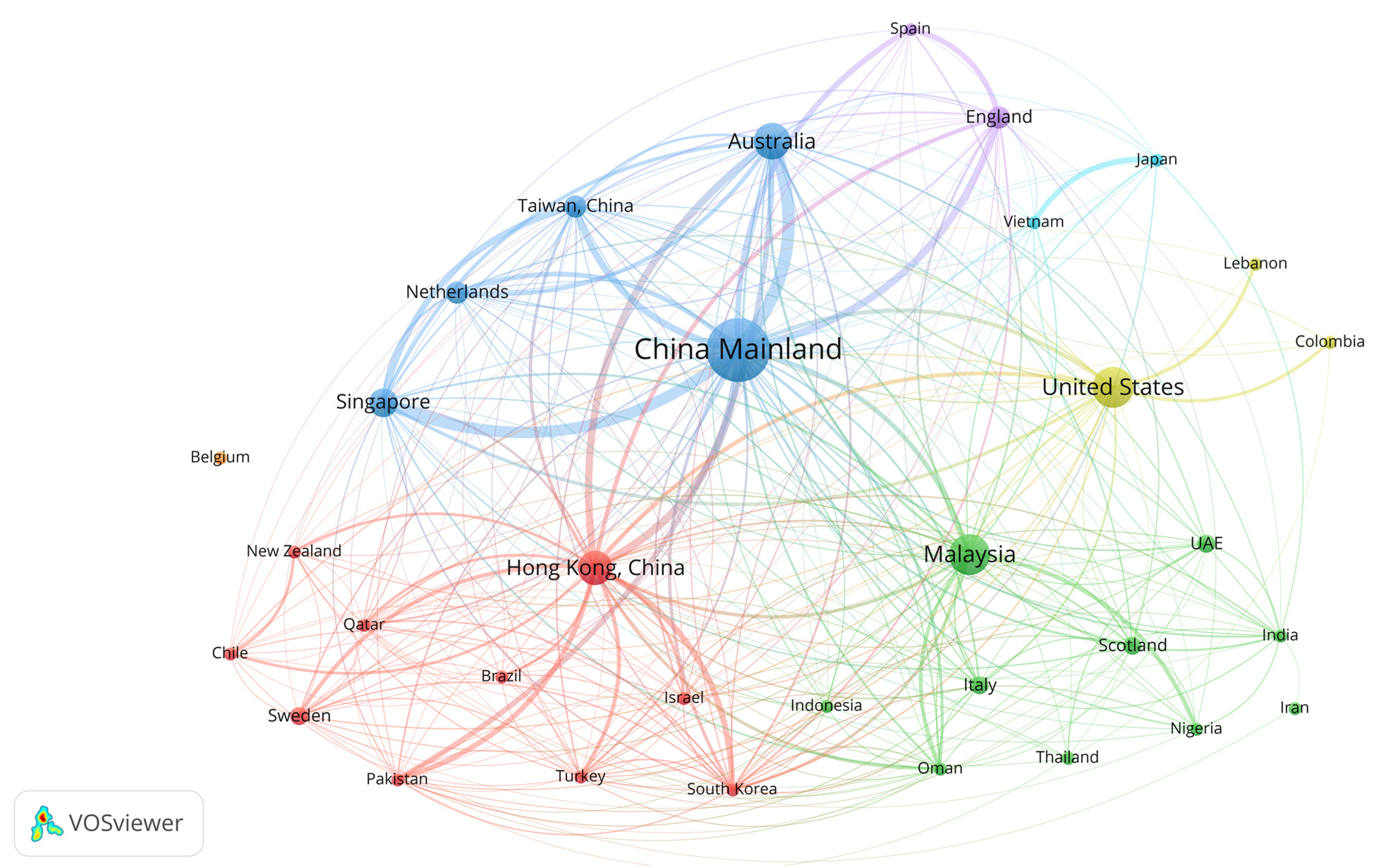

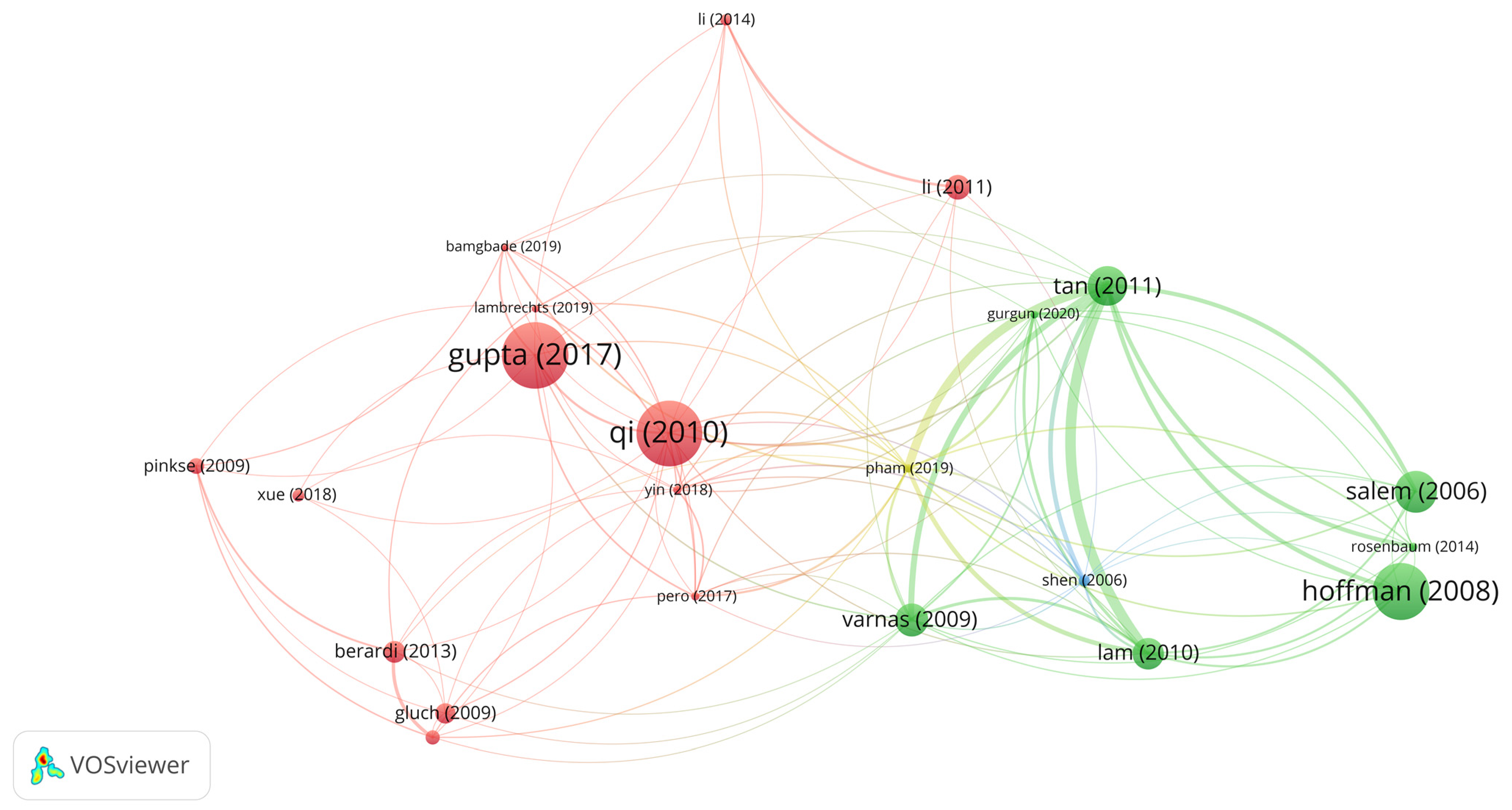

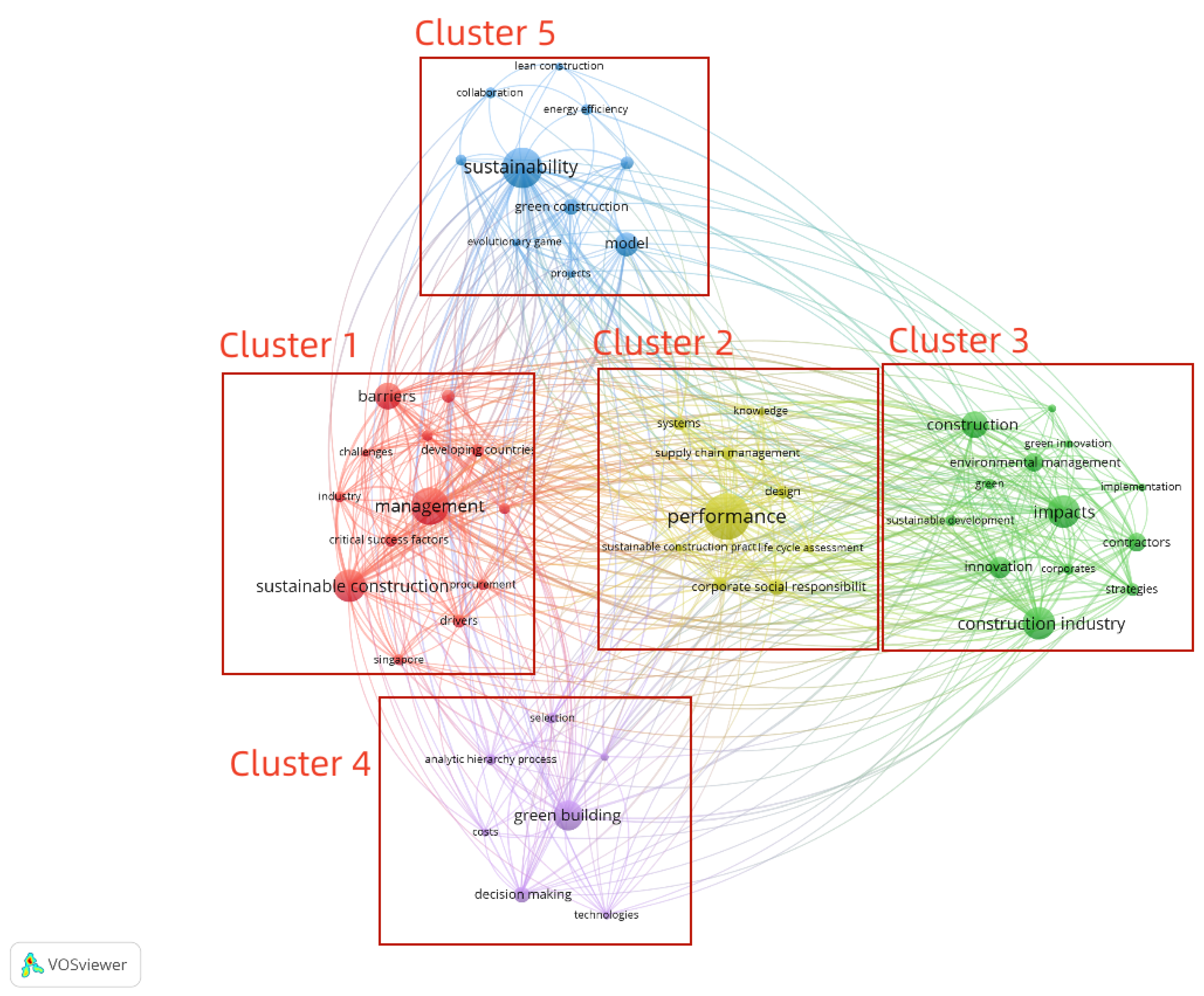
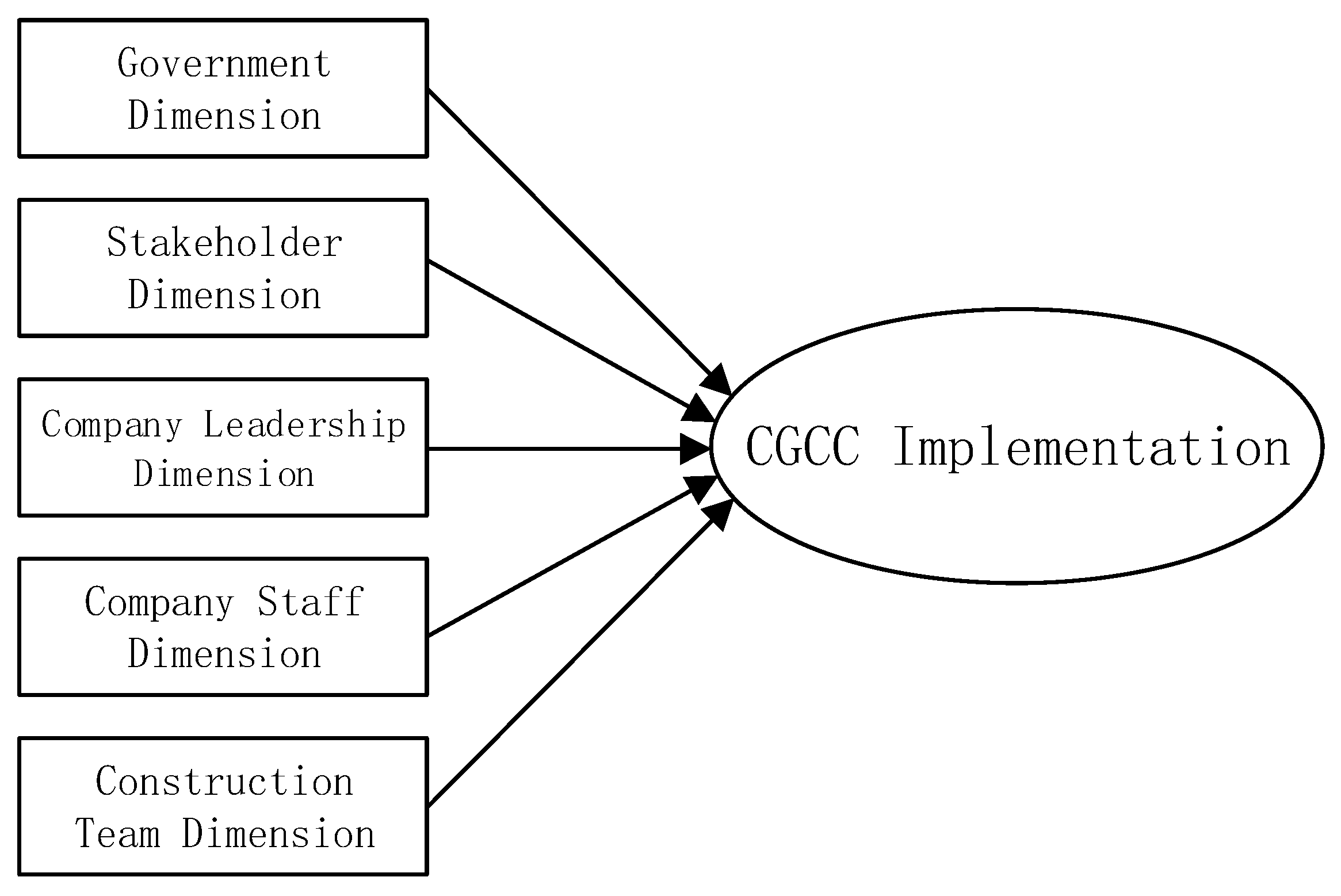
| Field | Numbers of Papers | Numbers of Journals |
|---|---|---|
| Environment & sustainability | 38 | 17 |
| Construction management | 26 | 16 |
| Engineering management | 3 | 3 |
| Financial management | 1 | 1 |
| Technology management | 1 | 1 |
| Law and political | 2 | 1 |
| General management | 1 | 1 |
| Energy management | 1 | 1 |
| Corporate social responsibility | 1 | 1 |
| Country/Region | ND | TC | TLS | AC | AY | NC | ANC |
|---|---|---|---|---|---|---|---|
| Mainland China | 24 | 554 | 2327 | 23.08 | 2018 | 22.8206 | 0.9509 |
| Malaysia | 10 | 47 | 460 | 4.70 | 2019 | 6.3429 | 0.6343 |
| United States | 10 | 609 | 391 | 60.90 | 2012 | 9.4574 | 0.9457 |
| Australia | 8 | 87 | 1217 | 10.88 | 2019 | 7.8069 | 0.9759 |
| Hong Kong, China | 7 | 597 | 1310 | 85.29 | 2013 | 7.6888 | 1.0984 |
| Singapore | 5 | 167 | 887 | 33.40 | 2015 | 5.4857 | 1.0971 |
| England | 3 | 65 | 498 | 21.67 | 2015 | 2.4945 | 0.8315 |
| The Netherlands | 3 | 85 | 243 | 28.33 | 2015 | 2.9893 | 0.9964 |
| Taiwan, China | 3 | 147 | 479 | 49.00 | 2013 | 2.9318 | 0.9773 |
| Italy | 2 | 81 | 121 | 40.50 | 2015 | 1.4301 | 0.7151 |
| Scotland | 2 | 31 | 110 | 15.50 | 2018 | 2.2143 | 1.1071 |
| Sweden | 2 | 194 | 127 | 97.00 | 2009 | 3.0794 | 1.5397 |
| UAE | 2 | 19 | 61 | 9.50 | 2021 | 1.2632 | 0.6316 |
| Document | Year | TC | TLS | Topic Relate to CGCC |
|---|---|---|---|---|
| Gupta and Barua [44] | 2017 | 248 | 26 | Contractor’s green innovation capability |
| Qi, Shen [45] | 2010 | 245 | 31 | Contractor’s green innovation capability |
| Hoffman and Henn [46] | 2008 | 212 | 40 | Barriers of CGCC |
| Salem, Solomon [47] | 2006 | 155 | 41 | Contractor’s lean construction capability |
| Tan, Shen [48] | 2011 | 145 | 437 | Contractor’s sustainable construction capability |
| Varnäs, Balfors [49] | 2009 | 121 | 87 | Contractor’s green purchase capability |
| Lam, Chan [50] | 2010 | 115 | 222 | Contractor’s green specifications |
| Salem, Solomon [51] | 2005 | 111 | 0 | Contractor’s lean construction capability |
| Li, Chen [52] | 2011 | 92 | 14 | Critical factors of CGCC |
| Berardi [53] | 2013 | 81 | 27 | Stakeholder’s impact on CGCC |
| Gluch, Gustafsson [60] | 2009 | 73 | 8 | Contractor’s green innovation capability |
| Pinkse and Dommisse [61] | 2009 | 58 | 13 | Barriers of CGCC’s adoption |
| Albino and Berardi [64] | 2012 | 51 | 26 | Firm relationship’s impact on CGCC |
| Xue, Zhang [62] | 2018 | 43 | 4 | Stakeholder’s impact on CGCC |
| Shen, Yao [63] | 2006 | 42 | 54 | Environmental performance of CGCC |
| TLS Rank | Keyword | Occurrences | TLS |
|---|---|---|---|
| 1 | sustainability | 15 | 70 |
| 2 | management | 14 | 66 |
| 3 | performance | 17 | 60 |
| 4 | barriers | 10 | 54 |
| 5 | sustainable construction | 11 | 50 |
| 6 | impact | 10 | 42 |
| 7 | construction | 10 | 39 |
| 8 | innovation | 8 | 37 |
| 9 | construction industry | 10 | 34 |
| 10 | critical success factors | 5 | 31 |
| Prominent Journal Outlets | Co-occurrence of Keywords Analysis |
|---|---|
| Journal of Cleaner Production | sustainability |
| Sustainability | management |
| International Journal of Construction Management | performance |
| Journal of Construction Engineering and Management | barriers |
| Sustainable Cities and Society | sustainable construction |
| Environmental Science and Pollution Research | impact |
| Co-authorship analysis | construction |
| Shen Liyin | innovation |
| A. Genaidy | construction industry |
| J. Solomon | critical success factors |
| Prominent organizations | Research clusters |
| Hong Kong Polytech University | implementation of CGCC |
| University Sains Malaysia | performance of CGCC |
| Top countries/regions | profound impact of CGCC |
| Mainland China | CGCC and green building |
| Malaysia | CGCC and sustainability |
| United States |
Disclaimer/Publisher’s Note: The statements, opinions and data contained in all publications are solely those of the individual author(s) and contributor(s) and not of MDPI and/or the editor(s). MDPI and/or the editor(s) disclaim responsibility for any injury to people or property resulting from any ideas, methods, instructions or products referred to in the content. |
© 2023 by the authors. Licensee MDPI, Basel, Switzerland. This article is an open access article distributed under the terms and conditions of the Creative Commons Attribution (CC BY) license (https://creativecommons.org/licenses/by/4.0/).
Share and Cite
Gu, J.; Guo, F.; Peng, X.; Wang, B. Green and Sustainable Construction Industry: A Systematic Literature Review of the Contractor’s Green Construction Capability. Buildings 2023, 13, 470. https://doi.org/10.3390/buildings13020470
Gu J, Guo F, Peng X, Wang B. Green and Sustainable Construction Industry: A Systematic Literature Review of the Contractor’s Green Construction Capability. Buildings. 2023; 13(2):470. https://doi.org/10.3390/buildings13020470
Chicago/Turabian StyleGu, Jianglin, Feng Guo, Xiaojing Peng, and Bin Wang. 2023. "Green and Sustainable Construction Industry: A Systematic Literature Review of the Contractor’s Green Construction Capability" Buildings 13, no. 2: 470. https://doi.org/10.3390/buildings13020470
APA StyleGu, J., Guo, F., Peng, X., & Wang, B. (2023). Green and Sustainable Construction Industry: A Systematic Literature Review of the Contractor’s Green Construction Capability. Buildings, 13(2), 470. https://doi.org/10.3390/buildings13020470







